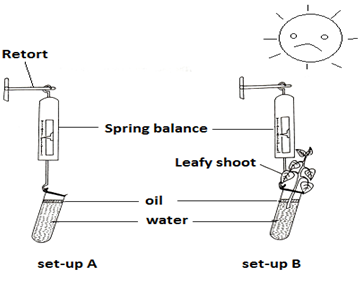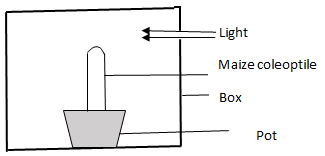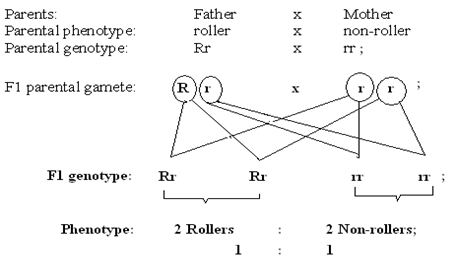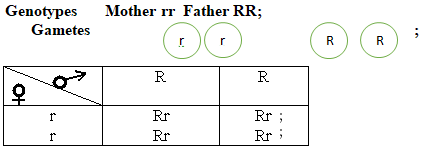INSTRUCTIONS TO CANDIDATES
- This paper consist of TWO sections; A and B.
- Answer all the questions in the section A in the spaces provided.
- In section B answer Question 6(compulsory) and either question 7 or 8 in the space provided after question 8.
SECTION A (40 MARKS)
- The set below was used to investigate a certain physiological activity in plants. The two set ups were left under a hot sun for several hours. Study it carefully to answer the questions that follow.
- What physiological process was being investigated? (1 mark)
- What was observed in set-up A and B at the end of the experiment (2 marks)
- Explain your answer in the (b) above for set-up B. (2 marks)
- What do you understand by the terminology guttation? (1 mark)
- Explain how wilting of leaves during a hot day is advantageous to a plant. (2marks)
-
- The diagram below illustrates the structure in the human eye.
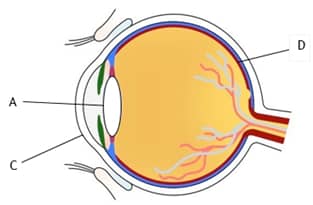
- State one way in which the part labelled c is suited to its functions. (1mark)
- State the functions of the cells in the part labelled D (2marks)
- State the changes that occur in part A to facilitate vision of a distance object. (2marks)
- A student set up an experiment as shown below.
The set up was left for three days.
Account for the expected results after three days (3marks)
- The diagram below illustrates the structure in the human eye.
- Tongue rolling is dominant over the inability to roll tongue. The father of a family can roll his tongue while the mother cannot. Half of their children can roll the tongue while the other half cannot. Use letter R to denote the tongue rolling trait.
- Explain with the help of a diagram why only half of the children in the case above inherit the tongue rolling trait from their father. (4 marks)
- If all children could roll the tongue, then what would be the genotype of the mother and father? Explain your answer using a punnet square. (4 marks)
- The micrographs below are of a tissue showing mitosis. Examine it and answer the questions.
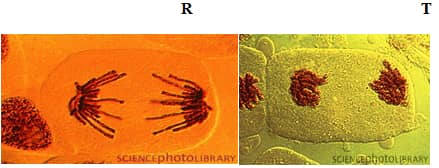
-
- Identify the tissue from which the micrographs were obtained (1mark)
- Give a reason for your answer in a) i above (1mark)
- Name the stages represented by R and T. (2marks)
- State two significance of mitosis to an organism. (2 marks)
- Name two regions in higher plants where cells actively undergo mitosis. (2marks)
-
- During a laboratory investigation, a scientist extracted gastric juice from the mammalian stomach. He used it to carry out tests on a food sample B which was suspected to contain proteins. He divided the food sample B into three portions and treated them as below.
- On the 1st portion of B, he added Gastric juice and mixed them thoroughly before adding sodium hydroxide followed with copper (II) sulphate drop by drop.
- On the 2nd portion of B, he added boiled gastric juice and mixed them thoroughly before adding sodium hydroxide followed with copper (II) sulphate drop by drop.
- On the 3rd portion of B, he added Gastric juice, sodium bi-carbonate and mixed them thoroughly before adding sodium hydroxide followed with copper (II) sulphate drop by drop.
- State the observations he made in each set up. (3marks)
- 1st portion……………………………………………………………………………………
- 2nd portion…………………………………………………………………………………
- 3rd portion………………………………………………………………………………………
- Why was the experiment on the 1st portion included in the tests? (1mark)
- Name the property of the chemical being investigated in these tests. (1mark)
- Account for the observations made in 2 (a) above. (3marks)
- State the observations he made in each set up. (3marks)
SECTION B (40MARKS)
Answer question 6 (compulsory) then choose any between question 7 and 8
- An experiment was carried out to investigate the effects of dilute sulphuric acid on the growth of plant seedlings. Batches of seedlings were grown in glass dishes on filter paper to which dilute sulphuric acid was added. The dishes were then incubated. The root and shoot lengths were measured after 65 hours. The results obtained are shown in the table below.
Sulphuric acid concentration (mol/dm-3) Mean root length (mm) Mean shoot length (mm) 0
1 x 10-3
3 x 10-3
4 x 10-3
6 x 10-3
7 x 10-3
8 x 10-3
9 x 10-3
10 x 10-355.5
63.4
6.5
2.0
1.8
1.5
1.3
1.3
1.025.2
18.4
9.5
4.6
0.8
0.5
0.3
0.0
0.0- Plot a graph of the mean root length and the mean shoot length against the sulphuric acid concentration on the same grid. (7 marks)
- Describe the relationship between the concentration of sulphuric acid and the:-
- Growth of shoots (2 marks)
- Growth of the roots (2 marks)
- Estimate the mean root and the mean shoot lengths when the concentration of sulphuric acid is 5 x 10-3
(2 marks) - State two other effects of acid rain. (2 marks)
- State three ways of preventing acid rain. (3 marks)
- Name two other gases with the same effect Sulphur (IV) oxide gas in the atmosphere. (2 marks)
-
- Describe the mechanism of inhalation and exhalation in mammals (14marks)
- Explain three factors that affect rate of breathing (6marks)
-
- Describe the process of double fertilization in flowering plants. (15marks)
- Describe what happens to the various parts of a flower after fertilization. (5 marks)

MARKING SCHEME
-
- Transpiration
- A – no significant change in mass; B – a lot of mass loss;
- B – presence of plant provide many stomata; hence large surface area for maximum water loss;
- Loss of water from the leaves in form of water droplets;
- Wilting leads to leaf folding; hence reducing the surface area of the leaf that is exposed to sunlight and stomata are less exposed hence reduce water loss (by transpiration);
-
-
- transparent to allow light into the eye; -curved to refract light to the eye;
- Rods for vision in dim light/low light intensity; cones for vision in high light intensity;
- Ciliary muscles relax; suspensory ligaments become tight and pull the lens; the lens become thinner and less refractive; light from a distant object is less refracted so the image is formed in the retina;
-
- to show/investigate the effects of unilateral/ unidirectional light on growth in plant shoot;
- Shoot bends towards the unidirectional light; the unilateral light causes the diffusion of auxins to the darker side; cells on the darker side grows and elongates faster than those on the lit side; hence curves towards light;
-
-
-
-
-
- Plant tissue ;
- It has got no centrioles;
- R – anaphase;
T– Telophase;
-
- Retention of chromosome number;
- give rise to new cells;
- Brings about growth in multicellular organisms; (ANY first 2)
-
- Root tip,
- Shoot tip,
- Cambium,
- Flower,
- Bud,
- Young leaf; (ANY first 2)
-
-
-
- 1st portion. - Blue; colour was observed
- 2nd portion – Purple; colour was observed
- 3rd portion – Purple; colour was observed
- A control experiment;
- Proteins are highly sensitive to temperature and pH changes; (award if either temp of pH is stated singly)
- 1st portion – Enzyme pepsin broke down proteins into peptones;
2nd portion – Enzyme pepsin works in acidic medium; (not in basic medium)
-
-
-
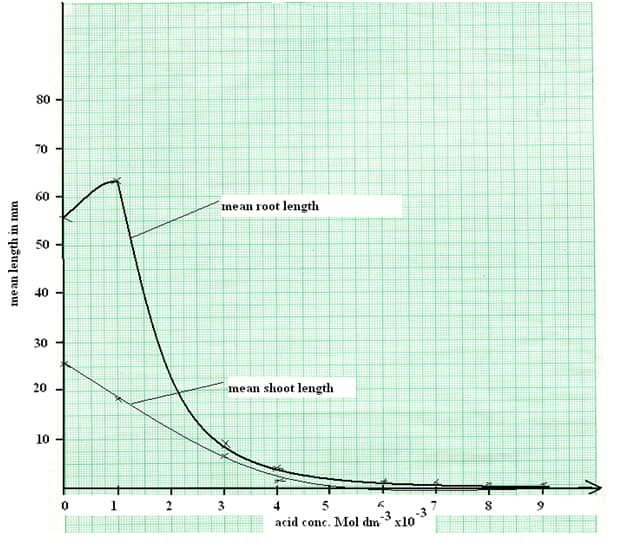
Title - ½ mk,Scale - ½ mk, Correct curves - ( 2marks)
Y axis – mean length in mm (2marks)
X axis – acid concentration (mol dm x 10) (2marks) -
- Growth of shoot – as the acid conc. increases, growth of the shoot decreases; due to the low pH which is toxic to the cells; (2marks)
- The length of the root increases slightly at the beginning; but as the acid concentration increase, the growth of the root decreases; low pH is not suitable for the growth of root; (2marks)
- At 5 x 10-3
- Mean shoot length 2.0mm ± 0.1;
- Mean root length 2.0 mm ± o.1; (2marks)
-
- Kills organisms in water and soil;
- Corrodes walls and roofs of buildings;
- Causes leaching of aluminum from soil; (any 2 points 2mks)
-
- Use of substances that extract sulphur from sulphur containing substances;
- Fitting chimneys with scrubbers that dissolve gases like sulphur dioxide and nitrogendioxide;
- More use of electricity instead of fossil fuels;
- Fitting automobiles with filters and catalytic converters in their exhaust pipes to reduce emission of sulpur oxides;
( any 3 points, 3mks)
- Nitrogen (IV) oxide; and Carbon (IV) oxide;
-
-
-
- Inhalation-External intercostal muscles contract ;internal intercostal muscles relax ; ribcage is raised upward and outwards; diaphragm muscles contract ,causing it to flatten; volume of thoracic cavity increases; while pressure decreases; due to higher atmosphere pressure Air is drawn in through nostrils ;making the lungs to inflate
- Exhalation –External intercostal muscles relax ;internal intercostal muscles contract ;rib cage is lowered downward and inward ;diaphragm muscles relax and it arches upward/resumes dome shape; Volume of chest cavity decreases/reduces; pressure increases above that of atmosphere; and air is forced out of the lungs;
-
- Exercise /Activities
- During vigorouse physical activities the rate of breathing increases so as to meet oxygen demand.
- Age -Young people have higher demand of oxygen since they are more active.
- Emotions –body emotions such as fear, anxiety and fright increases the breathing rate.
- Temperature – when the temperature is high, there is tendency to increase the breathing rate.
- Healthy –in health increases body temperature which tend to increase body metabolic rate hence increased breathing rate.
- Altitude –high altitude has low oxygen concentration leading to increase breathing rate.
-
-
- Pollen grains lands and sticks/adheres onto the stigma;
- It absorbs nutrients/sugary substances and germinates to develop a pollen tube
- Pollen tube penetrates the stigma and grows down through the styles
- It obtains nutrient from the style (tissues)
- (As the pollen tube grows down the style), the pollen tube nucleus is located behind the tip as it directs the growth of the pollen tube while the generative nucleus follows behind it.
- The generative nucleus divides by mitosis (mitotically) into two male nuclei;
- When pollen tube reaches the ovary, it enters the ovule through the Micropyle; it enters the embryo sac; its tip bursts open/ruptures;
- The pollen tube nucleus disintegrates creating a clear passage for the male nuclei; (into the embryo sac)
- One male nucleus fuses with the (two/both) polar nuclei; to form a triploid endosperm nucleus;
Total 15 max
Max 15
Rej. Degenerates for disintegrates
NB. If an illustration is used mark: -- Landing of pollen grains on stigma
- Germination of pollen grains
- Formation of pollen tube
- Position of correctly labelled generative nucleus behind the tube nucleus in pollen tube.
- Growth of pollen tube down the style
- Entry of pollen tube into the ovule (Max 6 marks)
-
- The stamens/petals/sepals/calyx/style wither and drop off/fall off
- The zygote (divides by mitosis to) form the embryo
- The endosperm nucleus (divides by mitosis) to form the endosperm. (Accept primary endosperm for endosperm)
- The integuments develop into a seed coat/testa
- The ovary develops into a fruit
- The ovary wall develops into a fruit wall/pericarp
Total 5 marks
Rej. Legmen for Testa/seed coat Max. 5
- Pollen grains lands and sticks/adheres onto the stigma;
Download Biology Paper 2 Questions and Answers - Pavement Mock Exams 2021/2022.
Tap Here to Download for 50/-
Get on WhatsApp for 50/-
Why download?
- ✔ To read offline at any time.
- ✔ To Print at your convenience
- ✔ Share Easily with Friends / Students

